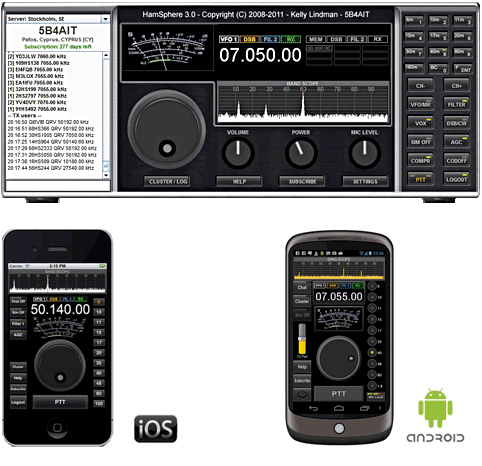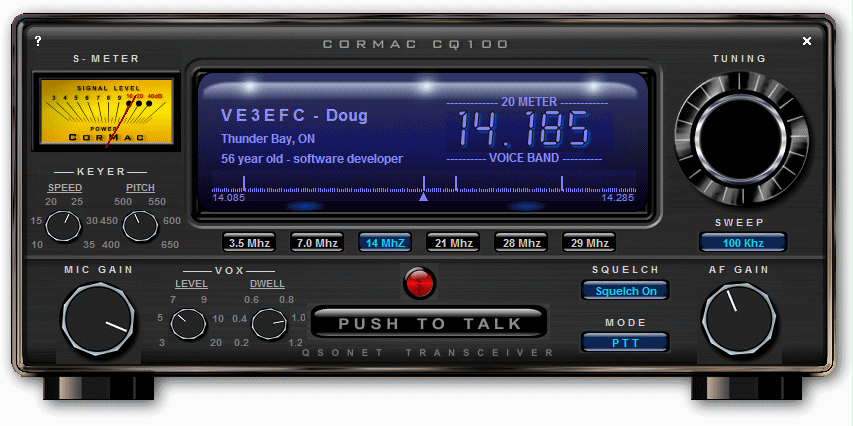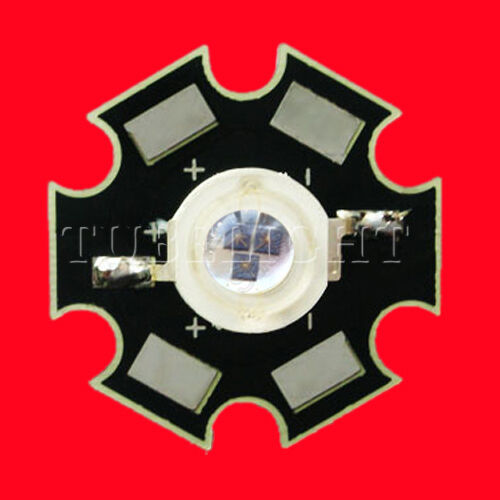As I prepare for my West Country holiday with my brother next week, I'm amused to see the QST advert for the Elecraft KX3 in use in very rocky terrain. Why am I amused? Well, there is no way that I'd take a "fully loaded" KX3 costing close to £1200 (in UK prices) up a mountain as shown in the photo!
It is OK taking a 12 year old FT817 or a 6 year old VX2 handheld: if these get damaged it's not be a disaster as I've already had huge value from them. But an investment of close on £1200 is another matter.
Perhaps I am not typical, but if I was to spend this sort of money I would not want to throw it in a backpack, risk dropping it on rocks or in a bog and getting battered and scratched. Also, being a very SMD intensive unit, repair is far from easy or low cost.
A better bet for a really portable transceiver to use in SOTA or other portable operations would be a rugged little direct conversion CW or DSB transceiver built into a strong die-cast case, probably for just a single band. It need not look pretty, just functional. Such a unit could be built to give good performance for under £20 buying EVERYTHING new. If dropped, one could easily fix it when back home. If it even got dropped in a bog and irrevocably damaged it wouldn't matter: just build another one!
No, something is wrong if anyone thinks they have to spend £1200 to climb a hill and enjoy amateur radio. I have no doubt the KX3 is a very excellent radio, but it is too expensive (for me) to use in backpack mode.
26 Apr 2013
Packing for clifftop operation next week
 |
| Operating pedestrian portable in South Devon |
For once the weather forecast is cold and reasonably sunny. Usually when I go back to Devon (where I was born and brought up) and it is raining all week my brother says, "you should have come last week - it was lovely".
Labels:
devon,
es,
ft817,
pedestrian portable
More eBay items for sale
 |
| http://myworld.ebay.co.uk/rlapthorn |
The Galapagos book cost £18.99 and is in MINT condition.
The Cinema of Isolation book is a very interesting study about how physical disability has been portrayed in the cinema over the last 100 years showing how attitudes have changed.
22 Apr 2013
23cms omni-directional horizontal antennas?
At the moment I'm still pondering the bands to try at my new QTH in a few months from now. One possibility is 23cms, a band I have never used on TX.
One consideration at the new QTH is antenna (non) visibility and I am anxious to go for "neighbour acceptable" solutions on all bands. For 2m SSB/CW/data I am still minded to use a couple of stacked big-wheel antennas giving around 5dBd horizontal gain. Up above the apex of the roof, this should soon be lost being not that much bigger than a TV yagi. The partly vertical feeder to this will load up on the HF bands as a nice stealth antenna: I have used the coax to my 10m halo as a very effective HF antenna, even on 472kHz despite being only a few metres long.
But what about 23cms? Maybe to just get on the band simply and with an unobtrusive antenna the Alford slot is worth a try? If I understand correctly, these give an omnidirectional horizontally polarized signal with around 10dBd gain. Placed at the top of the mast, maybe above the big-wheel and inside a PVC pipe as a radome, and fed with low loss coax (or with the transverter up near the antenna) this might be enough to work the locals during UKAC contests. Alford slots are popular for 23cm beacons and ATV, so why not for local 23cm SSB/CW activity or for weak signal data modes?
Another possibility would be a big-wheel (or should it be tiny wheel?) on 23cms. This would be about 12cms across only!
The photo above was from an eBay item which sold for around £130 back in April. Is anyone aware of commercially available 23cms horizontal omni-directional antenna?
One consideration at the new QTH is antenna (non) visibility and I am anxious to go for "neighbour acceptable" solutions on all bands. For 2m SSB/CW/data I am still minded to use a couple of stacked big-wheel antennas giving around 5dBd horizontal gain. Up above the apex of the roof, this should soon be lost being not that much bigger than a TV yagi. The partly vertical feeder to this will load up on the HF bands as a nice stealth antenna: I have used the coax to my 10m halo as a very effective HF antenna, even on 472kHz despite being only a few metres long.
But what about 23cms? Maybe to just get on the band simply and with an unobtrusive antenna the Alford slot is worth a try? If I understand correctly, these give an omnidirectional horizontally polarized signal with around 10dBd gain. Placed at the top of the mast, maybe above the big-wheel and inside a PVC pipe as a radome, and fed with low loss coax (or with the transverter up near the antenna) this might be enough to work the locals during UKAC contests. Alford slots are popular for 23cm beacons and ATV, so why not for local 23cm SSB/CW activity or for weak signal data modes?
Another possibility would be a big-wheel (or should it be tiny wheel?) on 23cms. This would be about 12cms across only!
The photo above was from an eBay item which sold for around £130 back in April. Is anyone aware of commercially available 23cms horizontal omni-directional antenna?
Labels:
23cm,
alford slot
Virtual amateur radio systems
 |
| http://www.hamsphere.com |
 |
| www.qsonet.com |
Huge leap in rechargeable battery technology?
The ExtremeTech website has reported a possible major major (i.e. game changing) breakthrough in Li-Ion battery technology with the headlines: New lithium-ion battery design that’s 2,000 times more powerful, recharges 1,000 times faster
If this turns out to be technology that can indeed be commercialised, then just imagine the possibilities: (1) electric cars with far lighter batteries, or electric car batteries with much greater range, (2) mobile phones with tiny batteries that can be charged in a minute or so, (3) portable HF transceivers that are half the weight of the FT817 but with batteries that last for days between charges.
It all sounds just a bit too good to be true, but I am sure this was no April Fool's joke.
 |
| http://www.extremetech.com/wp-content/uploads/2013/04/ncomms2747-f3.jpg |
It all sounds just a bit too good to be true, but I am sure this was no April Fool's joke.
Labels:
battery,
extremetech,
lithium battery,
lithium ion
20 Apr 2013
Optical communications in the 19th century
With the recent upsurge in interest in long range optical communications it is easy to forget that optical data communications over long distances predates radio communications by many years. In those far-off days the data was morse code and the light came from the sun in the form of a heliograph mirror that reflected the sun's rays over long distances in daylight. Keying was usually by tilting the mirror or by keying a grill placed in front of the mirror. See http://www.modulatedlight.org/Modulated_Light_DX/Heliograph.html . Best DX achieved in the 19th century was well over 200km using these methods!
Labels:
helio
Infra-red "over the horizon" tests?
Reading Stuart G8CYW's article on the history of optical communications in the latest RadCom, I am considering repeating my recent NLOS optical test using infra-red (IR) rather than visible light as there may be some advantages with clear air forward scatter propagation by going to lower near optical frequencies. At least IR beams are not visible to the casual viewer, so are less likely to create problems. However, IR can be more dangerous than visible light because the blink reaction that occurs with visible light does not happen. When using high power IR LEDs it is therefore even more important not to look into the beam and to take care where the beam is aimed, especially at close range. Never ever look into the beam at close range.
A suitable IR PIN diode is the SRH203-FA from Osram, widely available on eBay. As you can see from the image, the PIN diode detector has IR filtering (black colour) , so may be usable in daylight with less degradation than would be the case with red LEDs. I already use the SRH213 PIN diode for visible red optical comms.
 I am looking for a suitable 1W-3W IR LED and they are available, but I have yet to find one in the 10mm "fat" standard LED package that I use currently on 481THz.
I am looking for a suitable 1W-3W IR LED and they are available, but I have yet to find one in the 10mm "fat" standard LED package that I use currently on 481THz.
There are 3W IR LEDs available from China that should be suitable. See eBay item 370784927290 for example in the star package. This would be some 10dB more output than I currently use, although I am not sure of the beam divergence which may be greater than with the 10mm package.
Nanowave over-the-horizon experiments are very much like microwaves, except that the test equipment is a GREAT deal simpler!
A suitable IR PIN diode is the SRH203-FA from Osram, widely available on eBay. As you can see from the image, the PIN diode detector has IR filtering (black colour) , so may be usable in daylight with less degradation than would be the case with red LEDs. I already use the SRH213 PIN diode for visible red optical comms.
There are 3W IR LEDs available from China that should be suitable. See eBay item 370784927290 for example in the star package. This would be some 10dB more output than I currently use, although I am not sure of the beam divergence which may be greater than with the 10mm package.
Nanowave over-the-horizon experiments are very much like microwaves, except that the test equipment is a GREAT deal simpler!
13.8V distribution board
 |
| http://www.hamradio.co.uk/sysimages/origimages/PW-100-1_pr5198_1.jpg |
I see that Martin Lynch sell a Mydel PW-100 4-way distribution board with fuses on each output. Although a similar unit could easily be built, this is not a bad price for a ready-made unit complete with spare connectors at around 30 pounds.
When arranging my new shack I shall have to either buy one of these or make up something similar.
Labels:
martin lynch,
mydel,
pw-100
A walk in the sunshine with the Ventus GPS tracker
As the weather was so beautiful this afternoon (full sun and around 13 deg C) I decided to do a country walk and track my progress using the Ventus GPS data logger bought from Martin Lynch and Sons. The walk was 10.7km and took about 2hrs 34 minutes with a couple of relaxing breaks for a drink and a snack. No ham radio gear was taken this time, because I forgot to charge up my VX2 handheld. Next time, HI. Incidentally Quy was where my optical beacon reached (over the horizon) a few weeks ago. When you walk that far it seems a VERY long way away!
This is a plot of the walk taken with the low cost GPS tracker then plotted with Google Earth.
This is a plot of the walk taken with the low cost GPS tracker then plotted with Google Earth.
 |
| Today's walk in the Cambridgeshire countryside |
Labels:
martin lynch,
ventus g730,
walk
Subscribe to:
Comments (Atom)




